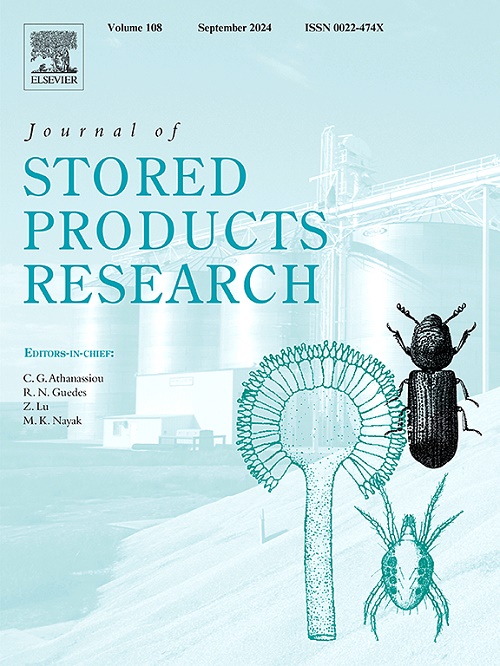Impact of red flour beetle Tribolium castaneum (Herbst) infestation in wheat flour on benzoquinone levels and biscuit quality
IF 2.7
2区 农林科学
Q1 ENTOMOLOGY
引用次数: 0
Abstract
The red flour beetle, Tribolium castaneum (Coleoptera: Tenebrionidae), negatively impacts the quality of wheat flour and its derived products. This study examines the effects of T. castaneum infestation at levels of 10, 20, and 40 pairs/kg over different storage periods (4, 6, and 8 months) on biscuits produced by infested flour. Key parameters assessed include moisture content, weight, diameter, thickness, spread ratio, sensory attributes, chemical composition, and benzoquinone accumulation. Results indicate that biscuit moisture content and weight increased with both infestation level and storage duration. After 8 months, the highest infestation level (40 pairs/kg) resulted in a moisture content of 10.75 % and a weight of 14.40 g, significantly higher than the control. Diameter increased while thickness decreased, leading to an increase in the spread ratio from 3.89 to 4.63. Sensory evaluation revealed a decline in appearance, taste, and aroma, negatively impacting overall biscuit quality. Chemical composition analysis showed an increasing trend in crude protein, crude lipid, and ash, while carbohydrate and fiber were decreased, and this attributed to insect infestation level and biscuit formulation. Additionally, Tribolium castaneum infestation raises benzoquinone (BQ) levels in wheat flour and its biscuits, with higher insect density increasing BQ secretion, which peaks between 4 and 8 months of storage. Statistical analysis confirmed significant differences across all tested parameters. These findings highlight the progressive deterioration in biscuit quality and safety due to T. castaneum infestation, emphasizing the need for preventive strategies to minimize economic losses and maintain product integrity.
小麦粉中红粉甲虫侵染对苯醌含量及饼干品质的影响
红粉甲虫(Tribolium castaneum)(鞘翅目:拟甲科)对小麦粉及其衍生产品的质量造成负面影响。本研究考察了不同贮存期(4、6和8个月)10对、20对和40对/kg castaneum侵染水平对受侵染面粉生产的饼干的影响。评估的关键参数包括水分含量、重量、直径、厚度、扩散比、感官属性、化学成分和苯醌积累。结果表明,随着虫害程度的增加和贮藏时间的延长,饼干的含水量和重量均有所增加。8个月后,最高侵染水平(40对/kg)导致水分含量10.75%,体重14.40 g,显著高于对照。直径增大,厚度减小,导致扩散比由3.89增加到4.63。感官评价显示外观、味道和香气下降,对饼干的整体质量产生负面影响。化学成分分析表明,粗蛋白质、粗脂肪和粗灰分呈上升趋势,而碳水化合物和纤维呈下降趋势,这与虫害程度和饼干配方有关。此外,castaneum侵染会提高小麦粉及其饼干中苯醌(BQ)的含量,昆虫密度越高,BQ分泌量越高,在贮藏4 ~ 8个月时达到峰值。统计分析证实了所有测试参数之间的显著差异。这些发现强调了castaneum侵染导致的饼干质量和安全性的逐步恶化,强调了采取预防策略以尽量减少经济损失和保持产品完整性的必要性。
本文章由计算机程序翻译,如有差异,请以英文原文为准。
求助全文
约1分钟内获得全文
求助全文
来源期刊
CiteScore
5.70
自引率
18.50%
发文量
112
审稿时长
45 days
期刊介绍:
The Journal of Stored Products Research provides an international medium for the publication of both reviews and original results from laboratory and field studies on the preservation and safety of stored products, notably food stocks, covering storage-related problems from the producer through the supply chain to the consumer. Stored products are characterised by having relatively low moisture content and include raw and semi-processed foods, animal feedstuffs, and a range of other durable items, including materials such as clothing or museum artefacts.

 求助内容:
求助内容: 应助结果提醒方式:
应助结果提醒方式:


